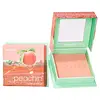What's inside
What's inside
 Key Ingredients
Key Ingredients

 Benefits
Benefits

 Concerns
Concerns

 Ingredients Side-by-side
Ingredients Side-by-side

Talc
AbrasiveMica
Cosmetic ColorantBoron Nitride
AbsorbentSilica
AbrasiveZinc Stearate
Cosmetic ColorantEthylhexyl Palmitate
EmollientDimethicone
EmollientParaffinum Liquidum
EmollientGlyceryl Caprylate
EmollientCucumis Sativus Fruit Extract
EmollientCarum Petroselinum Extract
Skin ConditioningAlthaea Officinalis Root Extract
Skin ConditioningCitrus Medica Limonum Peel Extract
EmollientCentaurea Cyanus Flower Extract
AstringentCalendula Officinalis Flower Extract
MaskingPunica Granatum Extract
AstringentEuterpe Oleracea Fruit Extract
Tocopheryl Acetate
AntioxidantRetinyl Palmitate
Skin ConditioningAscorbyl Palmitate
AntioxidantLauroyl Lysine
Skin ConditioningMethicone
EmollientKaolin
AbrasiveWater
Skin ConditioningPropylene Glycol
HumectantSodium Dehydroacetate
PreservativePotassium Sorbate
PreservativeCI 77891
Cosmetic ColorantIron Oxides
CI 75470
Cosmetic ColorantCI 45410
Cosmetic ColorantCI 73360
Cosmetic ColorantCI 15850
Cosmetic ColorantCI 19140
Cosmetic ColorantCI 77007
Cosmetic ColorantTalc, Mica, Boron Nitride, Silica, Zinc Stearate, Ethylhexyl Palmitate, Dimethicone, Paraffinum Liquidum, Glyceryl Caprylate, Cucumis Sativus Fruit Extract, Carum Petroselinum Extract, Althaea Officinalis Root Extract, Citrus Medica Limonum Peel Extract, Centaurea Cyanus Flower Extract, Calendula Officinalis Flower Extract, Punica Granatum Extract, Euterpe Oleracea Fruit Extract, Tocopheryl Acetate, Retinyl Palmitate, Ascorbyl Palmitate, Lauroyl Lysine, Methicone, Kaolin, Water, Propylene Glycol, Sodium Dehydroacetate, Potassium Sorbate, CI 77891, Iron Oxides, CI 75470, CI 45410, CI 73360, CI 15850, CI 19140, CI 77007
Synthetic Fluorphlogopite
Mica
Cosmetic ColorantZinc Stearate
Cosmetic ColorantLauryl Dimethicone
Skin ConditioningPentaerythrityl Tetraisostearate
EmollientAlumina
AbrasiveVinyl Dimethicone/Methicone Silsesquioxane Crosspolymer
Dimethicone/Vinyl Dimethicone Crosspolymer
Skin ConditioningCaprylyl Glycol
EmollientEthylhexylglycerin
Skin ConditioningDehydroacetic Acid
PreservativeParfum
MaskingTriethoxycaprylylsilane
Pearl Powder
Stearic Acid
CleansingLaureth-4
EmulsifyingWater
Skin ConditioningTocopherol
AntioxidantCI 77891
Cosmetic ColorantCI 19140
Cosmetic ColorantCI 77491
Cosmetic ColorantCI 77499
Cosmetic ColorantCI 77007
Cosmetic ColorantCI 15850
Cosmetic ColorantCI 75470
Cosmetic ColorantSynthetic Fluorphlogopite, Mica, Zinc Stearate, Lauryl Dimethicone, Pentaerythrityl Tetraisostearate, Alumina, Vinyl Dimethicone/Methicone Silsesquioxane Crosspolymer, Dimethicone/Vinyl Dimethicone Crosspolymer, Caprylyl Glycol, Ethylhexylglycerin, Dehydroacetic Acid, Parfum, Triethoxycaprylylsilane, Pearl Powder, Stearic Acid, Laureth-4, Water, Tocopherol, CI 77891, CI 19140, CI 77491, CI 77499, CI 77007, CI 15850, CI 75470
 Reviews
Reviews

Ingredients Explained
These ingredients are found in both products.
Ingredients higher up in an ingredient list are typically present in a larger amount.
Ci 15850 is the pigment color red. It is an azo dye and created synthetically.
Azo dyes need to be thoroughly purified before use. This allows them to be more stable and longer-lasting.
This ingredient is common in foundations, lipsticks, and blushes. This color is described as brown/orangey red.
It has many secondary names such as Red 6 and Red 7. According to a manufacturer, Red 6 usually contains aluminum.
Learn more about CI 15850CI 19140 is also known as Tartrazine. Tartrazine is a synthetic dye used in cosmetics, foods, and medicine to add a yellow color.
Tartrazine is created from petroleum and is water-soluble.
Some people may experience allergies from this dye, especially asthmatics and those with an aspirin intolerance.
Learn more about CI 19140Ci 75470 is a bright-red pigment. It is AKA carmine.
Carmine is derived from insects such as the cochineal beetle. This ingredient has been used as a natural dye for over 2000 years.
This pigment is called Ultramarine blue lazurite. It gives a saturated blue color, but can be used to create other colors as well.
According to the manufacturer, it is usually made from kaolin, sodium sulfate, sodium carbonate, sulfur, and charcoal.
Ci 77891 is a white pigment from Titanium dioxide. It is naturally found in minerals such as rutile and ilmenite.
It's main function is to add a white color to cosmetics. It can also be mixed with other colors to create different shades.
Ci 77891 is commonly found in sunscreens due to its ability to block UV rays.
Learn more about CI 77891Mica is a naturally occurring mineral used to add shimmer and color in cosmetics. It can also help improve the texture of a product or give it an opaque, white/silver color.
Serecite is the name for very fine but ragged grains of mica.
This ingredient is often coated with metal oxides like titanium dioxide. Trace amounts of heavy metals may be found in mica, but these metals are not harmful in our personal products.
Mica has been used since prehistoric times throughout the world. Ancient Egyptian, Indian, Greek, Roman, Aztec, and Chinese civilizations have used mica.
Learn more about MicaWater. It's the most common cosmetic ingredient of all. You'll usually see it at the top of ingredient lists, meaning that it makes up the largest part of the product.
So why is it so popular? Water most often acts as a solvent - this means that it helps dissolve other ingredients into the formulation.
You'll also recognize water as that liquid we all need to stay alive. If you see this, drink a glass of water. Stay hydrated!
Learn more about WaterZinc Stearate is the metal salt of stearic acid. It is a white solid used to bind, thicken, and lubricate products.
This ingredient is common in powder makeup, where it helps keep the powder together.
Zinc Stearate is hydrophobic and repels water.
This ingredient can be sourced from non-animal or animal sources. It is best to reach out to the brand to see where they source this ingredient from.
Learn more about Zinc Stearate